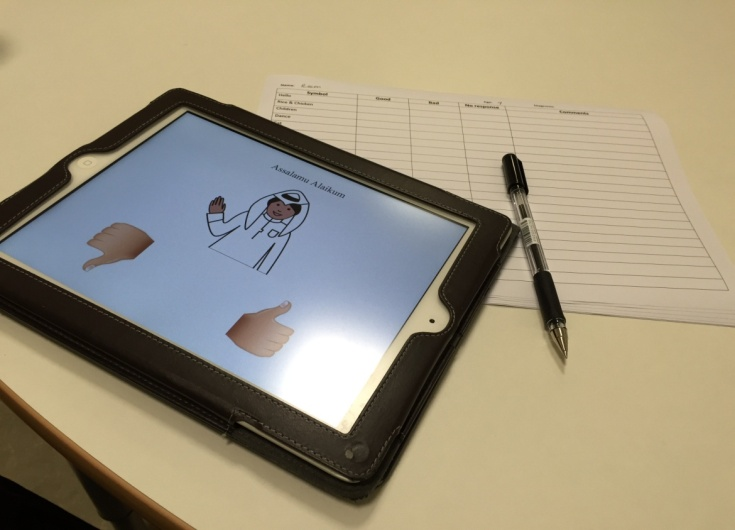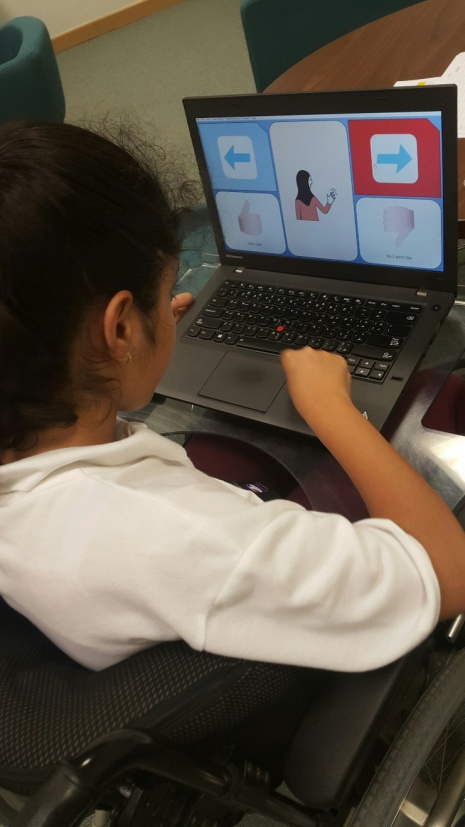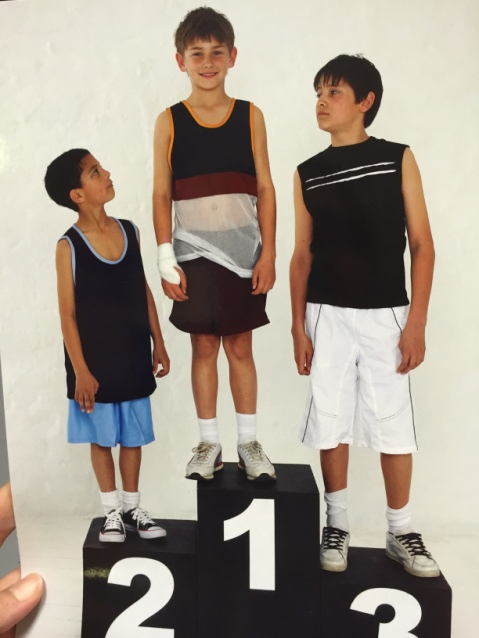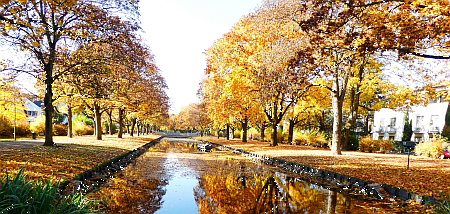 It has always been felt that it was essential that AAC users and those with communication difficulties should evaluate our symbols as part our research into symbol acceptance with real participation at all stages. We felt that this would ensure that the very people who would be using the symbols would provide us with feedback so we could tailor the symbols to their needs.
It has always been felt that it was essential that AAC users and those with communication difficulties should evaluate our symbols as part our research into symbol acceptance with real participation at all stages. We felt that this would ensure that the very people who would be using the symbols would provide us with feedback so we could tailor the symbols to their needs.
The team contacted the Speech Therapy team at Awsaj Academy for students with special needs to see if we could do a voting session with some of their students. Dr. Biji Philips arranged for 11 students to vote individually, with 15 minute time slots to complete the task. 2 students; a Tobii user with Cerebral Palsy and another with severe Autism required 30-45 minutes.
 The students were given 20 of our symbols to vote on and a thumbs up and thumbs down symbol to communicate their like/dislike for the symbol. Some students preferred to use okay as an option as well. Based on the student’s capacity judged online, Nadine and I asked why they liked/disliked the symbols. Some of the older students were superb and gave us detailed feedback relating to the need for more detailed facial expressions, or adding context to the symbol rather than just characters. Others did not want to let us down and said they liked the majority of the symbols. Here are the results of the voting sessions:
The students were given 20 of our symbols to vote on and a thumbs up and thumbs down symbol to communicate their like/dislike for the symbol. Some students preferred to use okay as an option as well. Based on the student’s capacity judged online, Nadine and I asked why they liked/disliked the symbols. Some of the older students were superb and gave us detailed feedback relating to the need for more detailed facial expressions, or adding context to the symbol rather than just characters. Others did not want to let us down and said they liked the majority of the symbols. Here are the results of the voting sessions:
Student comments
|
|
Good |
Ok |
Bad |
Comments |
Hello (Assalumu alaikum) |
11 |
1 |
– Not clear, waving or speaking– Saying hi and smiling– He tells how are you– Goodbye– Nice because he’s wearing Thobe– Nice clothes– Clear– Goodbye |
|
Rice & Chicken |
12 | – Only chicken
– Doesn’t look like our food – Chicken |
||
Children |
10 | 2 | – Not nice hair
– Put them in uniform – Boys |
|
Dance |
12 | – Very nice
– Sing – Nice because he’s dancing properly – Nice design |
||
Eat |
9 | 2 | 1 | – Looks angry
– I don’t see plate or water; I like that he’s opening his mouth and has spoon – Eat with hands – Don’t wear Thobe when you eat – Holding pen |
First |
11 | 1 | – Won
– Appropriate for Qatar |
|
Friends |
10 | 2 | – Uniform
– Like because it has 2nd and 3rd – Clear – Thobe are same – It’s nice how they hold each other – All the shoes black color – Shoes different – They shouldn’t hold their hands, it’s a shame |
|
House |
12 | – White + door white/gray; It’s big
– White + smaller – Two thumbs up – Like our house – Qatari houses are different |
||
Hug |
12 | – Change clothes color
– The girl is hugging her mother – Mom cuz wearing Abaya |
||
I |
10 | 1 | 1 | – Needs arrow on top of head
– Picture matches meaning – Full body – Not clear |
Mother |
10 | 2 | – Add rainbow color + lighten colors to look more happy
– Child holding hand + smiling – Put Abaya – Should be in Abaya. I know non-Muslims don’t wear it. Should wear Abaya wherever you go – Black Abaya |
|
Pray |
11 | 1 | – I like he’s praying
– Like him praying – Put him in the house. You don’t pray in the middle of the road – Clear |
|
Nursery |
12 | – Kids are playing and smiling
– Good – School – The colors are nice – Nice colors |
||
Please |
5 | 2 | 5 | – Add text
– She’s saying please and child should be angry – Open hands – Tilt head – Telling secrets – Not clear, I can’t see the two hands – Talk – Greeting |
Souq Waqif |
10 | 2 | – Add a lot of people
– It has Thobe and Abaya – Looks like the old days – Didn’t know – Change the buildings |
|
Pray |
7 | 5 | – Needs more colors + full mosque
– Not clear – Put someone praying + purple sky – There’s a bird – Didn’t know – It’s a mosque, not clear, maybe add colors. – I prefer the other praying symbol – Add colors |
|
Thank you |
8 | 1 | 3 | – Hand gesture is more I love you ; handshake
– Hold and shake hands – I do this for thank you – No hand on chest – He’s saying the national anthem – I don’t use this gesture for thank you – Hands greeting |
Travel |
10 | 2 | – More sky + men with yellow clothes
– Need stairs or bus – Terminal – Dad looks like brother – Add airport |
|
You |
10 | 2 | – They should look at each other
– Context. Add playground – Clothes are so different and shoes are different – Didn’t know – Not clear – Come |
|
Bye |
9 | 1 | 2 | – Show side profile + say bye to someone else
– Sad face for saying bye |

Overall it was a great voting session with some valuable feedback obtained. Speech therapists reinforced the need for such a project, giving the example of one student who “could not look at” a picture card used for inferencing emotions due to the image of the boys not covering their arms (picture below). Teachers also reported that students felt empowered by giving their feedback, as they had always been accustomed to receiving help, but on this occasion they felt they were able to help others.


